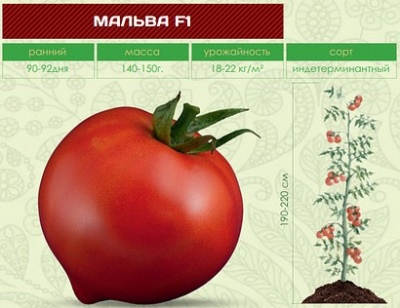
- Authors: Panchev Yu.I., Panchev Yu.Yu.
- Year of approval: 2018
- Category: hybrid
- Growth type: indeterminate
- Appointment: fresh consumption
- Ripening period: early
- Ripening time, days: 89-90
- Growing conditions: for open ground, for film greenhouses
- Marketability: high
- Transportability: Yes
Having named their development after a famous garden flower, plant breeders did not act recklessly. It turned out, indeed, a good result. However, even this attractive variety can please with its fruits only with very careful care of planting and taking into account all its main features.
Breeding history
Not much is known about her. The developers of Malva are breeders Y. I. Panchev and Y. Y. Panchev. Practical cultivation was officially allowed in 2018.
Description of the variety
By its nature, Malva belongs to indeterminate hybrids. They plant it both in simple vegetable gardens and in greenhouses under plastic wrap. The choice between these options is due to what the growing conditions are. Bushes can grow up to 1.8-2 m. Leafiness is moderate. The foliage itself is also medium in size and green in color.
The main qualities of the fruit
There is nothing unusual for the species as a whole. Initially, the berries are green. Moreover, they have not a simple green color, but with a light tint. As the crop develops further, it will turn red. The rest of the nuances are as follows:
the spread of the usual mass is from 160 to 190 g;
the shape of a stereotyped heart with poorly defined ribs;
5-6 fruits per cluster;
laying of brushes no earlier than above 7-8 sheets;
articulated type of peduncles;
a decent level of keeping quality.
Taste characteristics
It should be emphasized that the flesh of the Mallow fruit is distinguished by its expressive density. Comfortable sweetness is noted. There is a sour note. In general, the ensemble of tastes is harmonious.
Ripening and fruiting
Mallow is distinguished by its early ripening period. In most cases, the development of the crop occurs in 85-90 days. In the greenhouse and in the open field, the collection should be started almost simultaneously. As always, however, the influence of the weather will have to be taken into account.
Yield
The culture is distinguished by solid productivity. It will be possible to collect up to 21-22 kg of berries per 1 sq. m. More precisely, it can be said only with reference to the specific cultivation conditions and the characteristics of agricultural technology.
The timing of planting seedlings and planting in the ground
It is necessary to sow seeds 55 or 60 days before the approximate movement of seedlings into open ground. This period may differ in each region. The emergence of seedlings from seeds will take from 5 to 10 days. It is not recommended to keep seedlings for too long. It should be planted no later than the risk of spring frost disappears.

Growing tomato seedlings is an extremely important process, because it largely depends on whether the gardener will be able to harvest at all. All aspects must be taken into account, from seedbed preparation to planting in the ground.
Landing scheme
The pits should have a depth of 15-20 cm. For 1 sq. m of land, it is necessary to have no more than 4 bushes. A gap of 30-40 cm is left between the seedlings. The transplant itself is recommended to be done in the evening or in a cloudy moment.

Growing and care
Forming Mallow bushes is a must. Mostly they are led in 1 or 2 stems. There is no great need for protection against Alternaria. And also the plant quite stably transfers the defeat of the tobacco mosaic virus. However, preventive measures can be helpful in the midst of outbreaks of these infections.
In general, Malva is unpretentious. Nevertheless, it is recommended to weed it as needed. Peat or sawdust mulching is advisable. Top dressing begins 2-3 weeks after planting. For the first time, nitrogen is introduced in a mixture with potassium and phosphorus, but the further, the less nitrogen should be.




A plant needs different micronutrients at each stage of growth. All fertilizers can be divided into two groups: mineral and organic. Folk remedies are often used: iodine, yeast, bird droppings, eggshells.
It is important to observe the rate and period of feeding. This also applies to folk remedies and organic fertilizers.


Growing regions
The Malva variety is suitable for almost all regions of Russia, except for the most northern areas. The culture is capable of producing a good harvest in:
Western and Eastern Siberia;
edges and regions of the Far East, North Caucasus;
areas of the Lower, Middle and Upper Volga regions;
Black earth;
central, northern and northwestern zones of the European part of Russia.
Review overview
The plant was very popular with gardening connoisseurs. With good fertilization of the land, a decent harvest can be guaranteed. At the same time, sometimes the fragility of the branches causes inconvenience. Landing in greenhouses and in vegetable gardens gives approximately the same result. Leaving does not cause any difficulties.

























































































